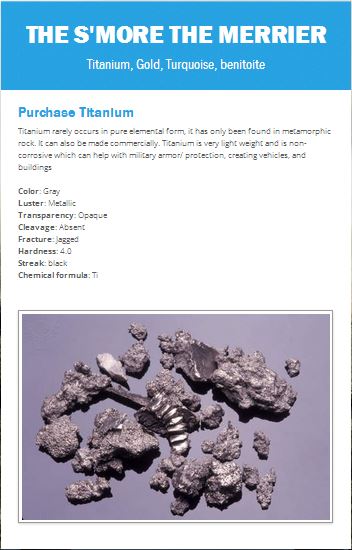Grant Odell, Deep Run High School
Summary
Throughout this lesson, students develop a deeper understanding of mineralogy; they practice and exhibit collaborative and communicative skills; and they reflect on the learning process. They are challenged to work in teams creating online brochures of minerals intended for sale. An online site (https://www.smore.com.) is utilized for creating brochures.
The librarian provides an overview of the ‘smore’ site, and shares tips for making brochures attractive and informative. She provides instruction in effective content searches and offers several “‘copyright friendly’ websites useful for collecting images. Students gather images and content regarding specific minerals and assemble them into an online sales brochure while working within a team.
The teacher and ITRT develop a online planning guide that is shared with (and within) each team. The guide promotes understanding and development of 21st century skills while ensuring that all team members become stakeholders in the project. Via the guide, the teacher can ‘peak’ into and provide suggestions and interventions regarding each team’s processes while the project is ongoing.
Once the brochures are complete, students share their individual projects via a “virtual gallery walk.” Through personalized Google Forms, students are asked to assess a small number of classmate’s work while providing high quality descriptive feedback (e.g., commendations and recommendations.) Viewing their peers’ brochures through the lens of the project rubric fosters skills for providing quality feedback. Critiquing other’s work and reading detailed feedback about their own projects develops self-reflection.
An ‘exit ticket’ survey allows students to offer feedback about the lesson continuing the reflective process for both the students and the teacher.
TIPC Ratings
In this lesson, resources are provided for researching and acquiring information and images yet students are encouraged to go beyond those resources in creating their brochures. The provided planning guide contains step by steps directions for advanced Google searches as well as links to other search sites and strategies that can be used. Students are individually and independently engaged in both the research and in the application of the acquired information to make their brochures informative and attractive. Additionally, the planning guide is designed for students to enter content, links, and questions that arise during the research acquisition phase. Students assemble their content and images to create a sale brochure simulating a ‘real world’ task. This lesson is rated as approaching.
Students work in teams using the Google Docs planning guide to help manage tasks, share insights and ultimately complete the class assignment. Via the web, each member of the team has access to their planning guide which contains information on time-tested behaviors necessary for quality collaboration. The guide allows and encourages students to reflect on their roles as team members, learners and communicators. Throughout this project, students collaborate planning, evaluation and sharing the brochures via Google Docs. This lesson is rated as approaching.
By design, critical thinking is infused throughout this project. Gathering, processing and honing information to solve a real world scenario (selling minerals) provokes students to think and analyze their processes. Students must apply digital tools (eg., online brochure software, Google Docs, numerous web sites) to accomplish the authentic tasks. In their planning guide, they generate their own questions to help guide the creative process and they think critically to best determine how to market minerals to be sold. They must also think critically when assessing their peers’ work. As a result of these actions and behaviors, this lesson is rated as approaching.
Expectations for students to be creative is emphasized in the research and assimilation portions of the project. While the software for creating the brochures is standardized (which helps make the project manageable for students and the teacher,) students have numerous choices in how they create their new products, the online sales brochures. Viewing the peers’ products helps students gain new strategies, insights and awareness about the creative processes. At the completion of the projects, students reflect on the processes while providing high quality feedback to the teacher about the lesson. This lesson is rated as approaching.
Download Files
- The lesson plan contains links to lesson artifacts (planning guide, rubric, peer feedback form and student feedback on lesson form)




